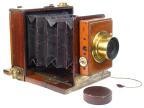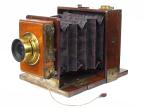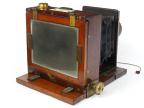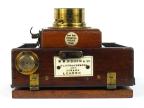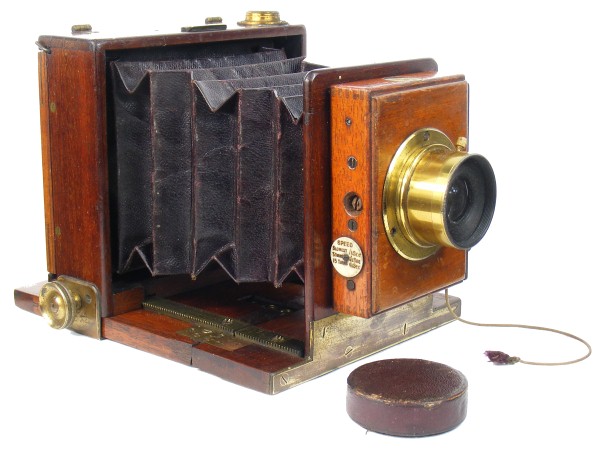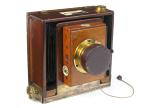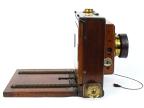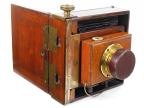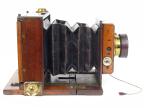Unknown Tailboard Camera
W W Rouch & Co
| Name: | Unknown (see Notes) |
| Type: | Tailboard Camera |
| Manufacturer: | W W Rouch & Co, London |
| Country of Origin: | United Kingdom |
| Construction: | Mahogany and brass tailboard camera of comparatively simple construction, with fine dovetail joints and single extension square cornered leather bellows. The baseboard is located in position, once folded down, by two sliding brass tongues on the underside. |
| Production Period: | Unknown |
| Plate / Film Size: | ¼ plate |
| Lens: | Wray, London F=4", f5.6 serial 11328 with iris diaphragm (see Notes) |
| Shutter: | Thornton Pickard Snap Shot rollerblind shutter (1/15, 1/45, 1/90 sec), serial 64928 (see Notes) |
| Movements: | None |
| Date of this Example: | c1880 (see Notes) |
| Serial Number: | No obvious serial number on camera body |
| Availability: |
|
| Inventory Number: | 654 |
|
Photos copyright © 2016 David Purcell. Do not use without permission. |
Description
This is a well made ¼ plate tailboard camera, of dark mahogany with narrow dovetail joints, produced by W W Rouch & Co. It has a relatively narrow front lens standard, which is surprisingly thin and insubstantial. The lens panel is fixed to the baseboard by use of a rigid brass plate. When folded down for use, the baseboard is locked in place by two brass sliders or tongues underneath the camera.
The camera has square section pleated maroon leather bellows, of single extension. The rear section of the camera is mounted as a carriage that engages on dual straight toothed racks to allow the camera to be focused. There are no movements provided on this camera.
A Thornton-Pickard Snapshot shutter is fixed to the front standard, with a Wray lens fixed to the front of the shutter, which retains its original leather cover. This is unlikely to be original to the camera (see Notes below).
The camera bears a large maker's label on the top edge of the rear carriage, identifying W.W. Rouch & Co as the manufacturer. The address on the label is 180 Strand, London.
A round spirit level is fitted on the top face adjacent to the maker's label and a fitting for a viewfinder, although either or both may have been fitted later. The camera has a tripod bush fixed in the tailboard and a second in one side of the carriage, thus allowing the camera to be used in landscape and portrait format.
Notes
Discussions with another collector have revealed that this camera is very similar to several others that were marketed by other makers. The Early Photography web site shows an example produced by J J Shew, identified as the Shew Pocket Camera (last accessed January 2025). This Shew model can be dated quite precisely to 1878 due to the maker's address recorded on the label (28 Wardour Street). However there is one significant difference between the Shew and Rouch versions in that the former does not have rack and pinion for focusing; rather the rear standard is held in place by a clamping screw.
Another similar camera was sold in Christie's auction on 9 September 2003 (lot 360, last accessed January 2025), identified as made by M. P. Tench (153 Fleet Street). From the photograph it looks like the Tench model also has rack and pinion focusing, like the Rouch.
The evidence points to a likely date for the Rouch camera of c1880, or possibly a year or so earlier.
The other obvious difference between the Rouch, and either the Shew or Tench cameras is that the Rouch is fitted with a Thornton-Pickard Snapshot shutter. According to Tom Holliday [9], the Snapshot shutter was first introduced in 1890. Clearly therefore it cannot be an original fit to the camera and was added at a later date. The Wray lens is also of a later date than the camera based on data in the Lens Vade Mecum [10].
The likely date of c1880 for this camera makes it one of the earliest that I have in my collection. As a fellow collector has pointed out, the camera therefore dates to the transition period when both wet-plate and dry-plate mediums were in use, but a few years before dry-plates became the norm for plate cameras.
If you have any further information about this camera or come across any supporting material such as an advertisement that provides further details, please contact me.
![[ ]](../../images/unchecked.png)
![[x]](../../images/checked.png)
